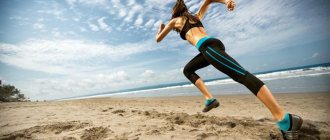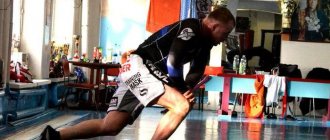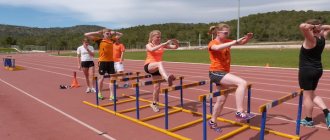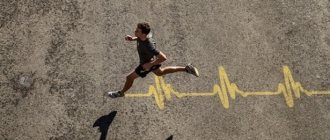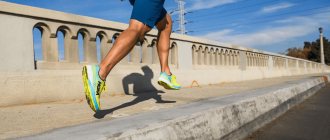Endurance is the most important physical quality, reflecting the general level of human performance and manifesting itself both in sports and in everyday life. Endurance needs to be developed in order to be able to endure any physical activity for a long time, in general, so as not to get tired for as long as possible. Endurance is like a habit - the body’s habit of a certain amount of stress.
The dependence of endurance naturally depends on the age of a person, that is, it changes with age; there is a moment when endurance increases and then declines. There are methods and programs for developing endurance. These are different workouts that have their own characteristics. Naturally, a poorly prepared person cannot withstand heavy training loads, so different methods are used, sometimes individual ones.
As mentioned above, endurance is the most important physical quality. It reflects the overall level of a person's performance.
Being a multifunctional property of the human body, endurance integrates a large number of processes occurring at various levels: from the cellular to the entire organism. As it turned out, the leading role in the appearance of endurance belongs to the factors of energy metabolism and the autonomic systems that provide it to the cardiovascular and respiratory systems, as well as the central nervous system.
Happy shopping on iHerb!
Endurance comes in two main forms:
- in the duration of work at a given power level until the first signs of severe fatigue appear;
- in the speed of performance upon the onset of fatigue. There is also a distinction between special endurance and general endurance.
Special endurance is the ability to endure long-term loads characteristic of a particular type of professional activity. Special endurance is a complex, multicomponent motor quality. By changing the parameters of the exercises performed, you can selectively select the load for the development and improvement of its individual components. Each profession or group of similar professions may have its own combinations of these components.
Special endurance is divided into types:
- complex-coordinated, strength, speed-strength and glycolytic anaerobic work;
- static endurance, associated with prolonged stay in a forced position in conditions of low mobility or limited space;
- endurance for prolonged work of moderate and low power; endurance to long-term operation of variable power; endurance to work in conditions of hypoxia (lack of oxygen);
- sensory endurance - the ability to quickly and accurately respond to external environmental influences without reducing the effectiveness of professional actions in conditions of physical overload or fatigue of the body's sensory systems. Sensory endurance depends on the stability and reliability of the functioning of the analyzers: motor, vestibular, tactile, visual, auditory.
General endurance is a set of functional capabilities of the body that determine its ability to perform long-term work with high efficiency at moderate intensity and form the nonspecific basis for the manifestation of performance in various types of professional or sports activities. Simply put, if a person has increased his aerobic abilities (they are the basis of general endurance) in one type of activity (for example, running), then the improvements will be reflected in another - cycling, skiing, etc. General endurance is the basis for high physical performance, which is necessary for successful professional activity.
Depending on the number of muscles involved, endurance varies:
- Global
(3/4 of the muscle mass of the body), global work causes the greatest increase in the activity of the cardio-respiratory systems of the body, in its energy supply there is a greater share of aerobic processes. - Regional
(from 1/4 to 3/4), regional work leads to less pronounced metabolic changes in the body; the share of anaerobic processes in its provision increases. - Local
(less than 1/4), local work is not associated with significant changes in the state of the body as a whole, but in the working muscles there is a significant depletion of energy substrates, leading to local muscle fatigue. The more local the muscular work, the greater the share of anaerobic processes of energy supply in it, with the same amount of externally performed physical work.
Endurance and age.
Bioenergetic factors are decisive in the manifestations of endurance, therefore the dynamics of its age-related changes are best judged by metabolic indicators.
At the age of 18 to 25 years, that is, during the period of physiological maturation of the human body and the formation of its mental sphere, a person’s aerobic and anaerobic capabilities increase and reach their highest limit. Then these figures gradually decrease, and by the age of 60 they are already almost half the maximum. However, there are certain age-related differences in the dynamics of anaerobic indicators.
The indicators of maximum anaerobic power (MAP) and glycolytic capabilities (as measured by the maximum concentration of lactic acid in the blood) change most dramatically with age. In men, MAM increases rapidly until the age of 20 years and remains at a high level until almost 30 years, then decreases by 12-18% every 10 years. In women, there is a faster increase in this indicator at a young age, and the maximum is reached by the age of 18, then it begins to decline and by the age of 30 it falls by 25-30%, after which it begins to decrease by 7-8% every 10 years.
The age-related dynamics of glycolytic capabilities are more pronounced. In men, the ability to accumulate lactic acid increases until approximately 30 years of age and remains at a high level until 40 years of age, after which it sharply decreases by approximately 10-12% every 10 years. In women, the maximum values of the ability to accumulate lactic acid in the blood are observed until the age of 30 years, then decrease by 11-15% every 10 years.
The age-related dynamics of maximum oxygen consumption (VO2) in men and women are similar, however, women reach aerobic capacity by the age of 20, and after 25 years this ability gradually decreases, and in men the highest VO2 are observed at the age of 25, and then decrease evenly . Aerobic capacity indicators change more slowly.
After 30 years, aerobic capacity declines, but in women more sharply than in men.
Special Stamina
Special endurance is the ability to overcome fatigue under certain conditions and limitations. For example, maintaining speed over a given distance or performing anaerobic exercise. The following types of special endurance are distinguished:
Express
This is a person’s ability to perform a large number of accelerations with the same technique and speed.
Speed-strength
We can talk about speed-strength endurance when a person uses strength to overcome fatigue in a multi-repetition approach, without losing technical performance.
Coordination endurance
It manifests itself mainly in gymnastics and complex games, where non-cyclical repetition of movements takes place.
Power
Doing heavy exercise without rest. It is divided into two subtypes: dynamic and static. In the first case, this is performance at medium intensity, the second is the ability to linger at peak tension.
Features of endurance training in bodybuilding
In bodybuilding, developing endurance is treated as a side effect of pumping up muscles.
In other words, no one specifically trains this quality. However, it develops well indirectly during various training periods.
For example, during pump training and high-repetition load modes, dynamic strength endurance improves.
The training methodology is aimed at developing slow muscle fibers:
- using light weights (50% of one rep max)
- high number of sets and repetitions
- minimal pauses between approaches (or their complete absence)
Static exercises are also used during the training process.
“Corners” for the press, planks and holding weights in various starting positions - all this contributes to the development of static strength endurance.
The greatest development of general (aerobic) endurance in bodybuilding occurs during the cutting period, but this is rather an additional bonus.
At this time, cardio training is carried out almost daily, lasting 40-60 minutes, and is used to accelerate fat burning.
Developing endurance
Certain factors can significantly influence performance when it comes to endurance. This is the amount of oxygen during exercise, namely the type of exercise: aerobic or anaerobic. These include the body’s own capabilities, the volume of its energy resource, functionality, the ability to quickly recover, the level of technical proficiency, as well as the psychological factor.
Endurance has many directions, so it’s worth immediately deciding in which direction we will move. You shouldn’t grab everything and limit yourself only to general endurance.
Let's start with the daily routine. In order to stock up on strength and increase the body’s sufficient resources, it is necessary to rest properly and regularly. Endurance without relaxation drops three times. Write a plan, or better yet, draw it. It should include a training schedule, bedtime, and wake time. Get up at the same time every day and write down your meals. Food should only be healthy and balanced. The body must receive a sufficient amount of vitamins and minerals. And proteins, fats and carbohydrates correlate with your life rhythm and work to accumulate energy.
Before training, eat slow carbohydrates in the form of porridge, you can add fresh fruit or honey. There can be many portions throughout the day, but they should not be large. Don't overeat, but don't starve either. Maintain a stable blood sugar level, as a lack of it leads to fatigue and loss of energy, but remember that excess leads to excess weight.
Endurance is the ability to overcome fatigue, so the secret to increasing endurance is to overcome it every time, from training to training, to walk “on the edge,” to jump over critical moments, to put yourself in conditions on the edge of possibilities.
A person who is actively working on himself has a completely different appearance; both his internal organs and the functioning of his vital systems are changed, naturally, for the better. For example, such an athlete may have increased lung capacity or heart muscle due to a large supply of oxygen. As a result of such changes, a person is more adapted to changes and quickly adapts to more complex conditions and sudden extreme situations.
Endurance[edit | edit code]
In sports terminology, endurance
is a person’s ability to perform long-term global muscular work of a predominantly or exclusively aerobic nature.
Depending on the type and nature of the work performed, the following types of endurance
: static and dynamic, local and global, strength and speed, anaerobic and aerobic.
According to the energy supply mechanism
endurance are classified into:
- Anaerobic endurance
. A component of special endurance, the ability to perform work primarily using anaerobic sources of energy supply (in conditions of lack of oxygen). Alactate anaerobic endurance - Lactate anaerobic endurance
. A component of general and special endurance, the ability to perform work using aerobic sources of energy supply (through the use of oxygen).
| Duration in seconds | Aerobic in % | Anaerobic in % |
| 0-10 | 6 | 94 |
| 0-15 | 12 | 88 |
| 0-20 | 18 | 82 |
| 0-30 | 27 | 73 |
| 0-45 | 37 | 63 |
| 0-60 | 45 | 55 |
| 0-75 | 51 | 48 |
| 0-90 | 56 | 44 |
| 0-120 | 63 | 37 |
| 0-180 | 73 | 27 |
| 0-240 | 79 | 21 |
Aerobic endurance is divided into the following types:
- Short
- from 2 to 8 minutes; - Medium
- from 8 to 30 minutes; - Long
- from 30 or more.
Anaerobic endurance can be divided into the following types:
- Short
- less than 25 seconds; - Medium
- from 25 to 60 seconds; - Long
- from 60 to 120 seconds.
By sports specialization
endurance is divided into:
- General endurance
is a person’s ability to perform work of moderate intensity for a long time with the muscular system fully functioning. It is also called aerobic endurance, i.e. fully supplied with oxygen. General endurance serves as the foundation for the development of special endurance. - Special endurance
.
The ability to perform work effectively, despite fatigue, in a certain type of sports activity. Strength endurance
. A type of special endurance, it is used to develop and maintain the quality of muscle contractile force until the end of the competition or training task. - Speed-strength endurance
is characterized by the performance of actions of a high activity of a power nature for a long time; - Speed endurance
. A type of special endurance, the ability to maintain the required speed until the end of a competition or training task. Used to develop coordination of muscle contractions. Training methods combine high number of sets with low number of repetitions and intensity in excess of 85%, with distances ranging from 60 to 120% of the race distance (i.e., for example, an athlete specializes in the 100-meter dash, this distance is taken as the reporting distance). Competition and one-time training can be used to develop speed endurance. - Coordination endurance
(repeated repetition of complex technical and tactical actions); - Local (muscular) endurance
. A type of special endurance. The ability to perform a given job for a long time due to the high level of oxidative and contractile capabilities of the muscles themselves. In most cases, the term is used as an analogue of strength endurance. - Static endurance
. A type of special endurance, the ability to maintain a pose for a long time or prolonged static stress. - Dynamic strength endurance
is characterized by performing heavy muscle exercises at a relatively slow pace, but for a fairly long time. - Mental toughness
. The ability to maintain, under conditions of heavy loads and fatigue, the required level of mental processes that affect the effectiveness of sports activities.
In sports with a cyclical nature of activity, endurance as a physical quality is one of the components that ensures high athletic achievements.
During any physical exercise lasting more than a few minutes, the main route of ATP resynthesis is oxidative phosphorylation in mitochondria, which use carbohydrates and lipids as energy fuel.
This process requires an adequate supply of oxygen delivered by the blood and an appropriate amount of energy sources. The latter can be extracted from reserves located in the muscle fibers themselves (glycogen, triglycerides, phosphagens), as well as from circulating blood (glucose and free fatty acids). Impaired ATP resynthesis can occur when intramuscular energy sources are depleted or when a decrease in the efficiency of muscle blood supply leads to a decrease in the delivery of energy substrates and oxygen to them.
Characteristics of Key Exercises for Development of Fundamental Motor Abilities
(after Fox and Mathews, 1981; Viru, 1995; edited by the author)
| Target quality | Load interval | Work-rest ratio | Intensity | Number of repetitions | Number of episodes | Blood lactate, heart rate |
| Maximum speed | 7-15 s | 1: 10 | Maximum | 5-8 | 2-5 | — |
| Anaerobic glycolytic power | 30-50 s | 1: (4-5) | Submaximal | 4-6 | 2-4 | > 8 1 > 180 |
| Anaerobic glycolytic endurance | 1-1.5 min | 1:3 | High | 8-12 | 1-3 | Maximum > 8 > 180 |
| Aerobic power | 1-2 min | 1: (1-0,5) | Higher average | 5-8 | 1-3 | 4-8 160-180 |
| Aerobic endurance | 1-8 min | 1: 0,3 | Average | 4-16 | 1-3 | 2,5-4 (5) 140-160 |
| Reduction, oxidation of fats | 20-90 min | — | Low | 1-3 | — | 1-2,5 100-140 |
The body reacts by changing its metabolic response to strenuous exercise following an endurance training program in the following ways:
- the respiratory exchange rate and muscle respiratory coefficient decrease;
- the plasma concentration of free fatty acids increases;
- the utilization of intramuscular triglycerides increases;
- the rate of muscle glycogen utilization decreases;
- blood glucose consumption by muscles decreases;
- lipid oxidation increases compared to carbohydrates;
- lactate accumulation in muscles is reduced.
Systematic exercise aimed at developing endurance causes muscular and cardiovascular adaptation, which determines the ways of providing energy and oxygen. This adaptation, including both ultrastructural and metabolic (enzymatic) changes, leads to improved oxygen delivery and extraction by contracting muscles, and also modifies and improves metabolic regulation in individual muscle fibers.
Muscular adaptation to training aimed at developing endurance predetermines the development of the following qualities:
- selective hypertrophy of type I fibers;
- increasing the number of capillaries per fiber;
- increase in myoglobin content;
- increasing the ability of mitochondria to oxidative resynthesis of ATP;
- increase in the size and number of mitochondria;
- increasing the ability to oxidize lipids and carbohydrates;
- increasing the use of lipids as energy;
- increase in glycogen and triglycerides.
Trained muscles exhibit a higher ability to oxidize carbohydrates. Consequently, more pyruvate can be reduced and passed through the Krebs cycle. At the same time, the ability of trained muscles to utilize lipids also increases. This occurs due to an increase in the activity of lipolytic enzymes and an increase in capillary density in the muscles, which allows the capture of more free fatty acids from the blood. The activity of enzymes in the endothelium of the capillaries of trained muscles increases as well as the ability of mitochondria to oxidize free fatty acids. However, the most important effect of enzymatic changes occurring in muscles under the influence of endurance training is an increase in the contribution of lipids and, accordingly, a decrease in the contribution of carbohydrates to oxidative energy metabolism (ATP resynthesis) during exercise at submaximal aerobic power.
Under the influence of training during physical exercise, there is a decrease in both the respiratory exchange coefficient and the local respiratory coefficient directly in the working muscles. The increase in lipid oxidation is apparently a consequence of the increased capacity for substrate oxidation compared to the glycolytic capacity, which exhibits a less pronounced response during endurance training.
In endurance athletes, the use of lipids for energy purposes increases compared to carbohydrates, not only when performing the same absolute power of muscular work, but also when performing the same relative power, expressed as a percentage of the maximum oxygen consumed.
Under the influence of training, there is a decrease in the utilization of intramuscular glycogen and blood glucose. In cardiac muscle, this glycogen-protective effect is mediated by the functioning of the glucose-fatty acid cycle, due to which an increase in lipid oxidation leads to the accumulation of intracellular citrate and subsequent inhibition of glycolysis at the level of phosphofructokinase.
Reducing the uptake and utilization of blood glucose by muscles also reduces the degree of glycogenolysis in the liver and provides better maintenance of blood glucose homeostasis during prolonged exercise. A decrease in the rate of carbohydrate oxidation in trained individuals during physical exercise is associated with a decrease in the rate of lactate production. When performing physical exercises of submaximal aerobic power, lactate concentrations in highly trained athletes are lower than in low-skilled athletes. This is true regardless of whether the intensity of physical exercise is expressed in absolute or relative terms. The observed effect is due to the resynthesis (gluconeogenesis) of lactate to glucose by the liver. In humans, the rate of gluconeogenesis in the liver during physical exercise under the influence of training becomes higher.
A decrease in the rate of carbohydrate oxidation and a decrease in the rate of lactate production contribute to the preservation of limited carbohydrate reserves in the body, since the rate of use of muscle glycogen under the influence of training becomes lower.
Due to the establishment of a close relationship between the presence of muscle glycogen as an energy fuel and the ability to demonstrate endurance, a decrease in the rate of glycogen consumption should be considered as the main factor contributing to an increase in physical condition in sports that require the manifestation of endurance quality.
Changes in substrate utilization that occur under the influence of training may also be associated with less disruption of ATP homeostasis during exercise: with the increase in mitochondrial functionality that occurs under the influence of training, smaller decreases in ATP and creatine phosphate and smaller increases in ADP and inorganic phosphate are required during exercise. time of physical activity to maintain a balance between the rate of ATP resynthesis and the rate of its utilization. In other words, with an increase in the number of mitochondria, the need for oxygen, as well as for ADP and inorganic phosphate per mitochondria, after completing the training program, becomes less than before the training.
It is known that the decrease in carbohydrate oxidation that occurs under the influence of training during muscle work is compensated by an increase in the rate of lipid oxidation.
This is a brief diagram of the peculiarities of the course of biochemical processes under conditions of training the quality of endurance. Pharmacological support for sports with a cyclic structure of physical work should be aimed at enhancing positive aspects (lipolysis, gluconeogenesis, etc.).
Table Pharmacological support for an athlete during physical endurance training
| Preparation stages | ||||
| Drugs | Retractor | Base | Pre-competition | |
| I | II | |||
| Multivitamins | * | * | * | * |
| Vitamin E | * | |||
| Vitamin C | * | * | ||
| Vitamin B15 | * | * | ||
| Anabolic drugs | * | * | ||
| Antihypoxants | * | * | ||
| Antioxidants | * | * | ||
| Adaptogens | * | * | ||
| Iron preparations | * | |||
| Preparations K, Mg | * | * | * | * |
| Nootropics | * | * | ||
| Hepatoprotectors | * | * | ||
| Drugs that improve microcirculation | * | * | * | |
| Sedatives | * | * | ||
| Energy | * | * | * | * |
| Riboxin (Inosine) | * | * | * | |
| Immunocorrectors | * | * | ||
Note
. The retracting stage is the preparation of body functions for stress, strengthening muscles and ligaments; basic I - bringing physiological functions and the rate of biochemical reactions to the maximum level; basic II - work on special endurance; pre-competition - fine-tuning the quality of endurance to a competitive level.
What to do to increase endurance?
Set a goal. Work on increasing your overall endurance once a week. Do a long distance run.
Develop all body systems, primarily respiratory and cardiovascular. Some exercises can be taken from yoga and bodyflex. Enjoy what you do. Pay attention to interval training, this is one of the most effective ways to increase the body's endurance. It is necessary to alternate the intensity of the load. For example, an athlete runs fast for one minute, and for four minutes he performs an exercise at an average pace. This could be push-ups, pull-ups, squats or abdominal exercises.
If your goal is to improve in certain disciplines, then complicate your training and create insurmountable conditions for yourself. As an option, create a lack of water during exhausting workouts or reduce oxygen supply. In such situations, hidden opportunities open up that we did not even suspect about. The body receives stress and uses its reserves.
Natural adaptogen "Elton Forte" to increase endurance
The desire to be first in sports is unrealistic without increasing muscle endurance. After all, strong and resilient muscles are the key to victory in any sports competition.
Developing endurance is also necessary to maintain health . Lack of physical activity, especially in older age, will quickly lead to muscle weakness and blood stagnation. As a result of this, the person's condition will gradually worsen. Therefore, you need to devote a sufficient amount of time to sports training.
To increase endurance and maintain health, it is not enough just to exercise. You need to sleep well, eat right and take natural supplements for endurance. Taking Elton Forte will help you more easily endure physical activity during training . This supplement contains eleutherococcus root, L-carnosine, royal jelly, bee pollen, as well as a huge amount of vitamins, minerals and amino acids. All these components, acting together, provide a maximum increase in endurance and prevent the occurrence of many diseases.
Endurance Products
Both professional athletes and amateurs often resort to various means, so-called assistants. Drugs that help athletes overcome fatigue and increase endurance are called adaptogens . Such adaptogens are known as radiola rosea (golden root), ginseng root, tincture of eleutherococcus. Such supplements can have a positive effect not only on endurance, but also on the body’s systems as a whole, increase the body’s resistance to infections, increase strength and accelerate the saturation of muscles with oxygen.
According to Comrade Brahman, scientist and doctor, there are three ways to increase physical endurance:
- The use of natural physical disciplines (hardening, acupuncture, physiotherapy, etc.)
- Psychological influence (hypnosis, psychotherapy)
- Medicines and sports supplements.
The world's toughest athletes
Based on the example of great athletes who achieved unprecedented heights, having mediocre physical data, it can be argued that human endurance goals can reach any level.
Adrian Solano
His long path in the sport went through the list of outsiders; he had never skied or practiced on snow before. At the World Ski Championships he was included in the list of the worst skiers on the planet. Literally, he fell and rose in every competition. But not only was he not upset by the failures, but he also increased the duration and frequency of his training.
Now the athlete provides charitable assistance to athletes. He is known throughout the world as one of the toughest men in the world of sports.
Pita Tuatofua
The famous taekwondo player Pita tried his hand at cross-country skiing many times. At the World Championships he took 153rd place out of 156. His performance at the Olympics was also unsuccessful for him. But an example of the fact that genes do not always play a role, giving way to focus and strength of character, is brought to us by Tuatofua.
Now spectators and sports fans specifically buy tickets to the island of Tonga just to watch the famous athlete.
Morning and evening jogging: when to train, pros and cons
Why do you need training?
In physical education, endurance is not only a way to improve the delivery of oxygen to all tissues and organs, but also to improve athletic performance. This is especially important in professional sports. But training endurance is useful for everyone - both athletes and those who want to strengthen the condition of their body.
The benefit of such exercises is that thanks to them:
- the total area of small blood vessels (capillaries), which serve as conductors of blood (and therefore oxygen) to the muscles, increases;
- the concentration of lactic acid decreases, which causes unpleasant painful sensations during physical activity;
- the heart muscle is strengthened, thereby increasing the heart’s ability to pump blood;
- the functionality of the lungs improves, as a result of which the blood is more saturated with oxygen;
- the size of mitochondria increases, which allows the release of energy released during the oxidation of organic compounds;
- red muscle fibers actively develop, contract slowly and for a long time and are weaker than white ones.
To become more resilient, you need to train repeatedly and perform a certain system of exercises.
When to expect an effect
It is useful to combine endurance exercises with flexibility and strength exercises. Provided you are systematic and consistently increase the load, changes will be noticeable within a month to a month and a half. During this time, muscle elasticity, a surge of strength, excellent functioning of the heart and respiratory system, and a lack of fatigue during the day will become noticeable.
When engaging in physical education, it is necessary to include exercises to develop endurance in the complex. This will ensure the normal functioning of many organs and systems, tone the muscular system and make the body beautiful.
Contraindications
Moderate physical activity is beneficial for everyone. But developing endurance requires certain efforts, which are not shown to everyone.
Such exercises are contraindicated:
- those who have serious problems with the cardiovascular system;
- asthmatics;
- people with a curved spine;
- obese patients;
- after recent operations;
- in case of damage to the musculoskeletal system;
- pregnant women.
For each of these categories of people, you should look for more gentle ways to develop endurance. Only a specialist can choose a lighter version of classes.



